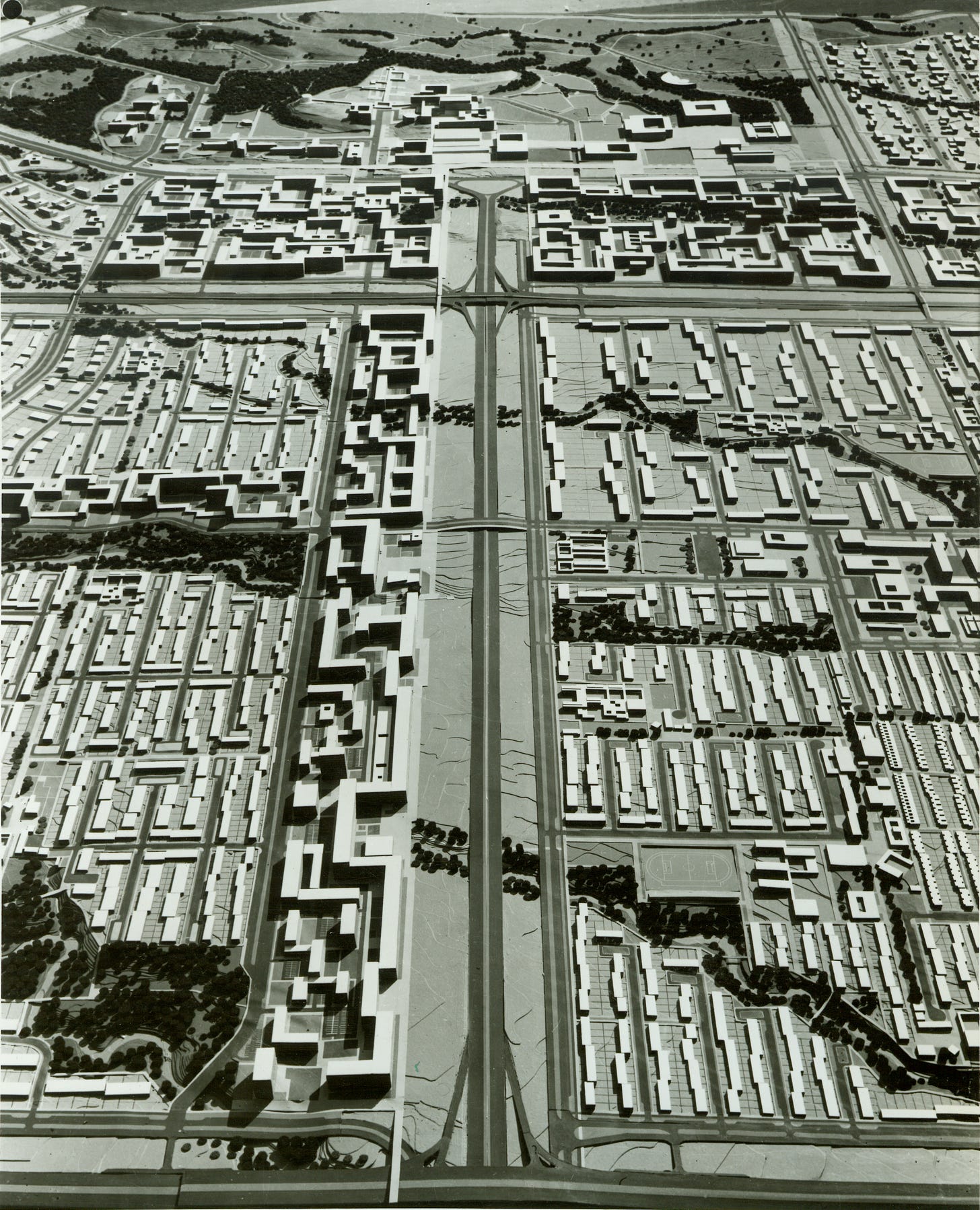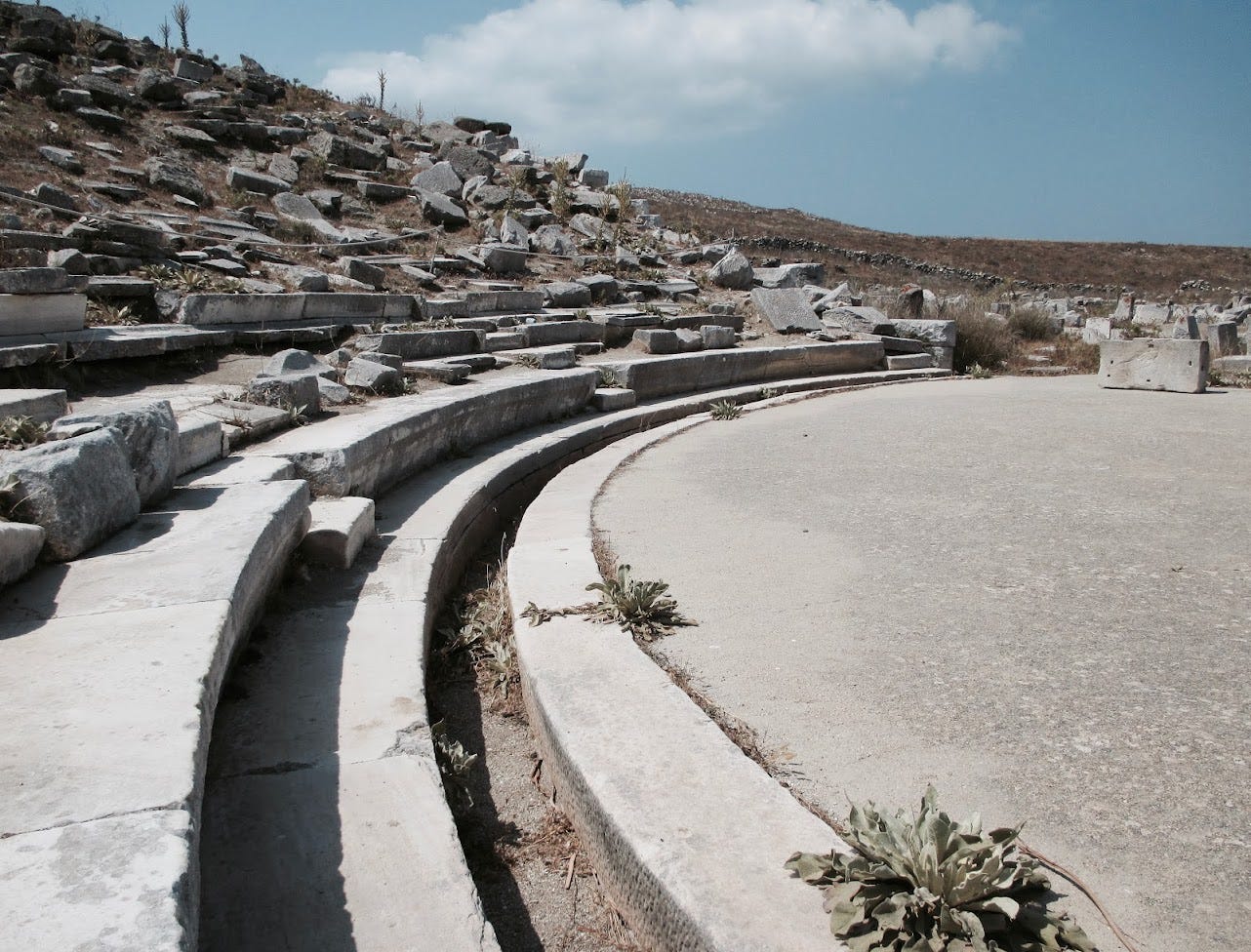The World Planner
A new series on the life and times of global architect and city planner C.A. Doxiadis (1913-1975)

In 1969, on the eve of the first moon landing, CBS correspondent Mike Wallace interviewed the global architect and urban planner Constantinos Doxiadis from the ancient ruins of Delos, an island once known as the birthplace of the god Apollo.
The segment was a CBS special spotlighting Doxiadis’ seventh Delos Symposion, an annual gathering of some of the world’s greatest intellectuals at the time, held aboard a cruise ship in the sparkling waters of the Aegean. Among the guests that year included space-age architect Buckminster Fuller, anthropologist Margaret Mead, and former U.S. Secretary of the Interior Stewart Udall. As such, the conference brought together leading intellectuals to grapple with the problems of the urban crisis and consider the possible solutions offered by Doxiadis’ trademark design philosophy of ekistics, what he defined as “the science of human settlements.”
But as Mike Wallace interviewed Doxiadis, the famous reporter displayed little interest in ekistics, nor the architect’s ambitious projects which spanned the globe. Rather, Wallace was preoccupied with what Doxiadis thought about the moon. With his characteristic snark, the correspondent asked, “at a time when our earthly concerns are so serious, Mr. Doxiadis, should we be dreaming of the heavens?”
The 56-year-old architect shifted his pose on the time-worn marble. The dark circles around his eyes revealed his exhaustion, but his rhetoric soared to meet the grandeur of his antique surroundings. “We must do it,” he said. “We have learned in humanity that in order to make progress on our problems, we must have the courage to reach far up… with some of us.”

Doxiadis proceeded to cite the courage of the ancient Greeks who explored the Aegean. He added, “and now, in order to reach a place we all need, the universal city of man, which is going to give us peace and happiness, we have to reach out, to the moon.”
Mike Wallace gave a sly grin. “Now that we’re there, Mr. Doxiadis, what should we do with the moon?”
Doxiadis smiled, bemused by the absurd question. “Well, first we must keep it in the sky. Because people don’t like moonless nights.”
To be sure, Doxiadis had fun with this response. He had a sense of humor. And with CBS broadcasting a segment on Doxiadis’ symposia, the architect had a great opportunity to make the case for his design approach to the American public.

The sheer volume and scale of Doxiadis’ projects more than justified the CBS spotlight. For decades, Doxiadis had worked in his homeland of Greece, where he had supervised the postwar reconstruction under the Marshall Plan; later, he had worked in Iraq, where he developed a massive national housing program, until a bloody coup curtailed the project; in Pakistan he had designed the capital of Islamabad from the ground up. In America, Doxiadis’ urban redevelopment project in Eastwick, Philadelphia, was touted by Senator Robert Kennedy; meanwhile he plotted a comprehensive and futuristic analysis of 866 counties in the Great Lakes Region. In total, his firm worked on projects in 40 countries, from Ghana to South Vietnam to Brazil.

In his time, Doxiadis’ productivity did not go unnoticed, and he was frequently profiled in American magazines. Some reporters wrote of him in superlative terms. Ada Louise Huxtable of The New York Times called Doxiadis city planning’s own “world supersalesman.” The New Yorker considered him“the greatest city planner now at work in the world.” In 1975, the geographer Jean Gottmann declared Doxiadis one of the four most important architects and planners of the 20th century, alongside Raymond Unwin, Le Corbusier, and Frank Lloyd Wright.
Doxiadis’ contributions overshadowed his personal story—born a refugee of the Balkan Wars in modern-day Bulgaria, he grew up the son of a cabinet minister in Athens. In World War II, his military experience as an artillery officer on the Albanian front evolved into his leadership of a clandestine resistance group during the Axis Occupation of his country.
After his surprise dismissal from his governmental role implementing the housing program of the Marshall Plan in Greece, he had gone into exile as a tomato farmer in Australia, only to return to found a massive global planning and consulting firm of 700 employees, its offices on a hill overlooking the Acropolis. The firm was followed by a technical school, a graduate school, a think tank, a journal, and a computing center. All of these efforts were complemented by this conference series on the Aegean, conversations on the island of Apollo.

Had Mike Wallace given Doxiadis the chance during the Delos conversation, the planner might have discussed the ecumenopolis, his startling forecast for an urban network which spanned the entire globe. But no—Wallace was more interested in the moon.
The broadcaster was not the only one.
In college I was drawn to urban studies, excited by the sublime architecture of Frank Lloyd Wright and the strange quality of Le Corbusier’s absolutist maxims.
In 2015, at the suggestion of an academic advisor, I began researching the life and times of Constantinos Doxiadis, a global architect and planner. This research formed the basis of my undergraduate thesis at Princeton, which earned four departmental awards upon graduation. But all the same I felt like my work was incomplete.
Doxiadis’ life story was like a grand tapestry for the arc of the history of architecture and planning over the course of the twentieth century. It touched on the story of the world wars, decolonization in South Asia and West Africa, the rise and fall of modern architecture, and the American urban crisis—important chapters within the history of the twentieth century.

I proceeded to conduct archival research at the Doxiadis Archive at the Benaki Museum in Athens, the Reuther Library at Wayne State University in Detroit, the Library of Congress in Washington, D.C., and the Harry S. Truman Presidential Library in Independence, Missouri. Among my travels I conducted field visits to his project sites in Eastwick, Philadelphia, Aspra Spitia in Greece, and Doxiadis’ hometown of Asenovgrad in Bulgaria. And I’ve talked to many people—scholars, practitioners, and figures close to the original planner and his team. And I’m grateful to the many people who have lent their time to speak with me and the archivists who have assisted my efforts.
As of this writing, the biography project remains a work in progress. But in my research I uncovered some tangents that do not fit the main biographical thread of the story. Without timely news leads, these stories do not lend themselves well to placement in conventional media outlets.
Yet these stories are illuminating for their wonder and complexity, their capacity to say something greater about the ambition and struggles of the twentieth century, and I feel that they deserve to be shared—they can no longer wait. And that’s what this newsletter series, The World Planner, is about.
This series will chronicle episodes in my biographical investigations into the life and times of global architect and city planner Constantinos Doxiadis. These pieces take longer to write than the other posts, so they’ll appear on an intermittent basis. You can keep up with the series on its homepage. A free subscription to The Usonian or its offshoot The Cyprus Files will give you access to all the posts in The World Planner.
If you have stories you’d like to share about Constantinos Doxiadis and the world of ekistics, please write to me at doxiadisbiography[at]gmail.com. I’d love to add them to the files.
I thank my readers for going on this journey with me. I’ll see you on the road.
“The Heritage of Apollo” (CBS News, 1969) segment can be found at the Doxiadis Archive in Athens (Archive File: 29147).

This is the first essay in a new series, The World Planner, chronicling my biographical investigations into the life and times of global architect and city planner Constantinos Doxiadis. These pieces take longer to write than the other posts, so they’ll appear on an intermittent basis. Keep up with the series on its homepage.

